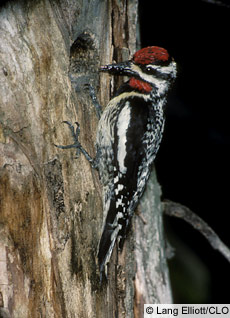EARTH DAY PRESS RELEASE: Kids Discover Bird Species #100 in Wild Warner Park
Madison, WI—A magical thing happened in Wild Warner one afternoon this April. A nationally-renowned ornithologist helped Sherman Middle School students and UW-Madison college students find the 100th bird species—a yellow-bellied sapsucker–in Madison’s largest urban park.

“There it is,” said ornithologist John Robinson, pointing to the colorful woodpecker on the trunk of a black walnut tree on Monterey Drive. Robinson, author of “Birding for Everyone: Encouraging People of Color to Become Birdwatchers,” came to Madison specifically to work with Sherman Middle School’s Bird Buddies program. This program is a community partnership between Wild Warner, the Gaylord Nelson Institute for Environmental Studies and Sherman Middle School. Robinson also gave a public lecture at UW-Madison on outdoor recreation and human diversity.
It’s taken nearly three years for the Wild Warner bird list to hit the magic number of 100. Trish O’Kane, a UW-Madison Ph.D. student in Environmental Studies, began compiling the list in 2008 as part of her research. Members of the Madison Audubon Society, UW-Madison ornithology students, Wild Warner members and local residents have also helped compile the list (See list under ABOUT US)
“When I first started, I did not expect to find over 100 bird species in such a seemingly urbanized park,” O’Kane said. “But I kept finding more and more and then the list stalled at bird #95 this winter. And then Robinson stepped into the park with the kids and hit 100. What a thrilling moment that was.”
O’Kane added that over 40% of these 100 species breed in Wild Warner: “Our park is a giant bird nursery.”
According to the species list, Wild Warner is home, fueling station or playground for birds as varied as the ground-nesting American Woodcock and a Bald Eagle that occasionally thrills park users with its hunting antics. Many of these birds are also long-distance migrators. Some travel as far as South America to spend the winter.
You must be logged in to post a comment.